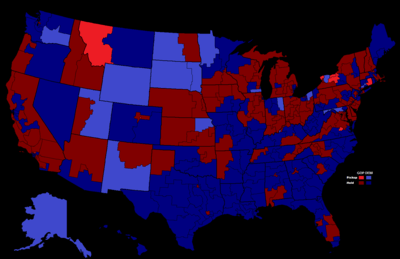1970 United States elections
The 1970 United States elections were held on November 3, and elected the members of the 92nd United States Congress. The election took place during the Vietnam War, in the middle of Republican President Richard Nixon's first term. Nixon and Vice President Spiro Agnew campaigned heavily for Republican candidates, with Nixon encouraging voters to respond to anti-war and civil rights activists by voting the Republican ticket. In an October speech he declared, "My friends, I say that the answer to those that engage in disruption--to those that shout their filthy slogans, to those that try to shout down speakers--is not to answer in kind, but go to the polls on election day, and in the quiet of that ballot box, stand up and be counted: the great silent majority of America."[2][3] Despite these White House efforts, the Democratic Party retained its Senate majority and increased its majority in the House.
| Midterm elections | |
| Election day | November 3 |
|---|---|
| Incumbent president | Richard Nixon (Republican) |
| Next Congress | 92nd |
| Senate elections | |
| Overall control | Democratic Hold |
| Seats contested | 35 of 100 seats (33 seats of Class 1 + 2 special elections) |
| Net seat change | Republican +1[1] |
 | |
| 1970 Senate election results
Democratic gain Democratic hold | |
| House elections | |
| Overall control | Democratic Hold |
| Seats contested | All 435 voting seats |
| Popular vote margin | Democratic +8.7% |
| Net seat change | Democratic +12 |
 | |
| 1970 House of Representatives election results
Democratic gain Democratic hold | |
| Gubernatorial elections | |
| Seats contested | 37 (35 states, 2 territories) |
| Net seat change | Democratic +11 |
 | |
| 1970 gubernatorial election results Territorial races not shown Democratic gain Democratic hold | |
In the House of Representatives, the Democrats picked up twelve seats at the expense of the Republican Party.[4]
In the Senate, Republicans picked up two seats and James L. Buckley won election as a member of the Conservative Party of New York. As of 2016, Buckley is the most recently elected third party member of Congress, although several independents have since won election to Congress.[5]
Until 2018, this was the last midterm election cycle in which a sitting President's party made net gains in one chamber of Congress while suffering net losses in the other chamber.[6][7]
See also
References
- Republicans gained two seats in the regularly-scheduled elections but lost one seat in a special election.
- "1970 Election, Nixon's Nominations". United Press International. Retrieved 1 June 2020.
- Peters, Gerhard; Woolley, John T. "Richard Nixon; Remarks in Kansas City, Missouri; October 19, 1970". The American Presidency Project. UC Santa Barbara. Retrieved 1 June 2020.
- "Statistics of the Congressional Election of November 3, 1970" (PDF). U.S. House of Reps, Office of the Clerk. Retrieved 8 October 2011.
- Joe Lieberman won re-election in 2006 on the Connecticut for Lieberman party line, but this transient party was created only after Lieberman lost the Democratic nomination and Lieberman served in the Senate as an independent Democrat.
- Kane, Paul (13 October 2018). "Stark political divide points to a split decision in midterm elections". The Washington Post. Fred Ryan. Retrieved 1 June 2020.
- Shapiro, Ben. "8 Big Takeaways From The Midterm Elections". The Daily Wire. Forward Publishing LLC. Retrieved 1 June 2020.